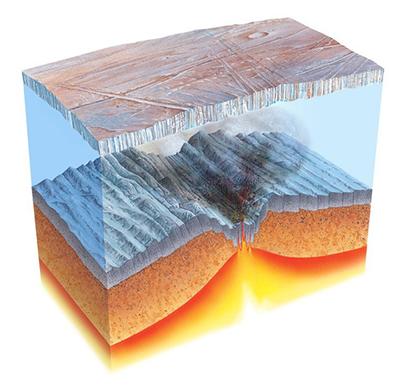Volcanoes kick-start life
Volcanoes altered ocean chemistry, stimulating production of multicellular organisms.
Some 720–640 million years ago, the Earth was virtually frozen, buried in massive ice sheets with surface temperatures as low as -50°C. One of the big mysteries of this ‘Snowball Earth’ is how and why the ocean chemistry changed as the ice suddenly melted. Dr Tom Gernon, Associate Professor in Earth Science at the University, sheds light on the important role volcanoes played in this extreme climate state.
Geoscientists believe that Snowball Earth was triggered by the break-up of a supercontinent called Rodinia. The resulting fragments were clustered near the equator where there are higher temperatures – resulting in increased evaporation of water from the oceans, which led to more precipitation. This also meant faster rates of chemical weathering: rain water reacting with mineral grains in rocks to flush dissolved minerals via rivers into the oceans. “This changed the ocean chemistry and used up a lot of atmospheric CO2, which normally traps heat inside the atmosphere – propelling the Earth into a severe ice age,” says Tom.
“Add to this the fact that, once frozen, the Earth was largely white, reflecting rather than absorbing the sun’s energy, the planet became locked into the Snowball Earth state for tens of millions of years.”
One of the big mysteries for geoscientists is how and why the ocean chemistry changed as the ice suddenly melted, explains Tom. “But now our study, published in Nature Geoscience, has shed light on this conundrum, demonstrating how underwater volcanoes during Snowball Earth played a crucial role in this transformation. The results help explain how our planet got oxygen in its atmosphere and oceans – enabling life to evolve from single-celled organisms into animals.”
Icehouse to greenhouse
The team suggests that the accumulation of millions of years' worth of carbon dioxide emissions from ongoing volcanic activity led to sufficient atmospheric warming to rapidly melt the ice cover of Snowball Earth. “In addition, there was effectively no weathering on the ice-covered land surface, and the ice layer covering the sea prevented CO2 from being taken up by the oceans. The result as Snowball Earth ended was one of the most extraordinary icehouse to greenhouse transitions the planet has ever experienced,” Tom says.

One manifestation of this sudden shift are thick deposits – still visible in places including China and Namibia – known as ‘cap carbonates’, formed in the warm waters after Snowball Earth.
But for such deposits to form, the sea water would have had to be highly alkaline. Previous studies have suggested that the ocean alkalinity could have increased due to weathering of pulverised rocks on land during the glacial meltdown.
“However, if the meltdown was as rapid as we think, it would have required unrealistically high rates of weathering, several orders of magnitude greater than today, to produce the cap carbonates. For this reason, the source of alkalinity has been one of the greatest enigmas in geology.”
The team’s research proposes an alternative explanation, involving widespread explosive underwater volcanism. During the break-up of Rodinia, tens of thousands of kilometres of mid-ocean ridge formed over tens of millions of years. The lava erupted explosively in shallow waters due to low pressure, producing large volumes of a glassy pyroclastic rock called hyaloclastite.
“As these deposits piled up on the sea floor, chemical reactions between the rock and the largely ice-covered ocean led to massive amounts of calcium, magnesium, silica and, perhaps most significantly, phosphorus being released,” says Tom. “Our calculations show that this chemical build-up is sufficient to explain the thick cap carbonate deposits.”
The results help explain how our planet got oxygen in its atmosphere and oceans – enabling life to evolve from single-celled organisms into animals.
Phosphorus, oxygen and life
It is the high phosphorus levels that are thought to have been the catalyst for the oxygenation of the atmosphere and oceans. Phosphorous is one of the key elements of life – crucial for the creation of DNA and cell membranes. Before Snowball Earth, most living organisms in the sea were free-floating bacteria consisting of just one cell. But the high phosphorus levels, largely caused by the underwater volcanism, would have stimulated the production of multicellular organisms such as algae in the ocean.
As these organisms – largely made up of carbon, hydrogen and oxygen – were continuously buried on the seafloor, the carbon remained there, leading to an increase in free oxygen levels in the water and atmosphere. The algae and cyanobacteria also produced and released oxygen via photosynthesis – crucial for animal life to evolve.
“It’s counterintuitive that one of the most extreme climate states our planet has ever experienced may have actually stimulated the origin of complex life forms. But this does now appear to be the case.”
